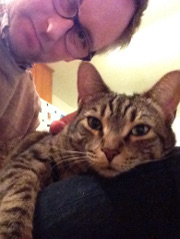 This month, we discuss photographs and their vicissitudes with Daniel Smyth, Mellon Postdoctoral Fellow at the Sage School of Philosophy of Cornell University. (And yes, Smyth used to study and teach at the University of Chicago!) Click here to listen to the episode.
This month, we discuss photographs and their vicissitudes with Daniel Smyth, Mellon Postdoctoral Fellow at the Sage School of Philosophy of Cornell University. (And yes, Smyth used to study and teach at the University of Chicago!) Click here to listen to the episode.
In this episode, Smyth asks: What does a photograph evidence? Away from philosophers, you might simply answer: A photograph evidences what it depicts. And it depicts what happened — what a camera detected in front of it when the photograph was taken. Of course, no? Well, consider the three photographs below (and keep them in mind as you listen to this episode). We can start with a straightforward photograph. Amidst the Olympics, you may have seen a photograph like this one:
Hooray for the Bahama’s Shaunae Miller! She’s the one who literally dove to victory, in lane seven. And too bad for the United States’s Allyson Felix, in lane four. This photograph evidences Miller’s victory by depicting it. That, after all, is what a camera detected in front of it when the photograph was taken, on Monday.
But, evidently, you are not at the Olympics, for you are on a philosophy podcast’s blog. So you will remember that, of course, photographs can’t all be so straightforward. Consider this second photograph, then:
What is being depicted here? And how? Notice that the numbers, which you can see clearly, are on the horses, not the track, which is a blur. The photograph depicts the horses in full, but it turns out that it only depicts the track’s finish line. Listen to Smyth to understand just how this works! In short, a “photo finish” like this one doesn’t simply depict the area a camera could have detected in front of it when the photograph was taken. Rather, such a photograph depicts what happened right at the finish line, over the period of time that the horses crossed it, way back in 1953. Common photography, as in the first image, would only have depicted a blur, whereas this photograph evidences a three-way tie! Hooray for Patchover, Payne Hall, and Penny Maid!
Such photography sure proved helpful in 1987, for instance:
This third photograph, also a photo finish, evidenced that Sabine Busch ran the race in 53.24 seconds, just ahead of Cornelia Ullrich’s 53.55 seconds. (Hooray for Busch.) For us as philosophers, the stories of these three photographs evidence: What a photograph depicts depends on how a camera detects what’s in front of it. More generally, what a photograph evidences depends on how the photograph is made.
Listen to Smyth to hear about the making of even more complex photographs, such as those of animal cells and outer space. And then consider the vicissitudes of what photographs evidence, and mean!
Dominic Surya



Leave a Reply